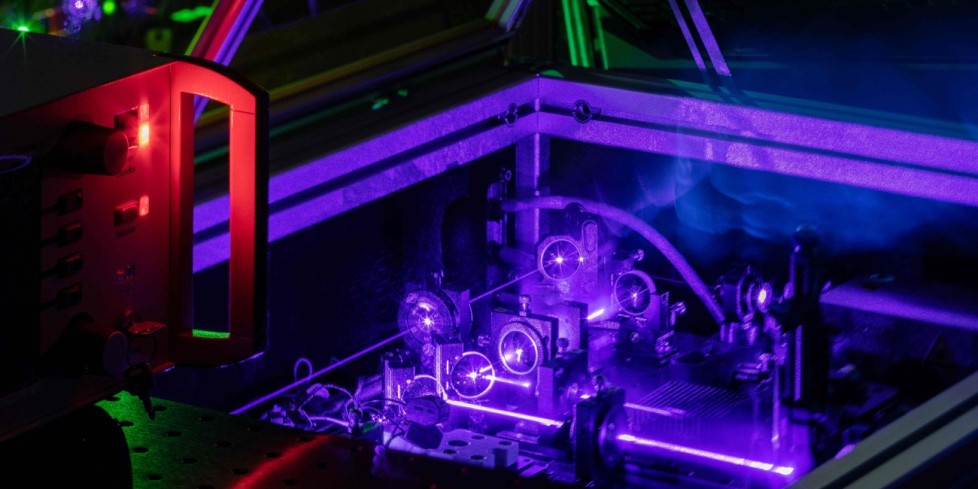Images as if by magic
Research of the Experimental Solid State Quantum Optics Group
2023/11/03 by Christian J. Meier
Quantum physics enables a new form of imaging that could make cancer diagnostics more precise. Physicists from Darmstadt, Jena and Barcelona have made quantum imaging more resilient to noise which may pave the way for practical applications such as in medicine.

Is it possible to take pictures of objects with light that does not even touch the object? That would be very useful in tumour diagnostics, for example. Here the aim is to take pictures with infrared light in order to distinguish healthy tissue from tumour tissue. But the problem is that image sensors for infrared light do not deliver the same image quality as those for visible light. But what if the image information could be transferred from infrared light to visible light before it falls on an optical image sensor? Then you could take pictures with infrared light just as well as with visible light. What sounds like a magic trick can be achieved with the help of quantum physics. But this “quantum imaging” is easily disturbed by ambient light.
What sounds like a magic trick can be achieved with the help of quantum physics.
Now physicists from Darmstadt, Jena and Barcelona have perfected a variant of quantum imaging so that it is hardly affected by ambient light. Cancer diagnostics could soon benefit from the method developed by the five-member team led by Darmstadt physics professor Markus Gräfe. In addition to the Technical University of Darmstadt, the Fraunhofer Institute for Applied Optics and Precision Engineering (IOF) in Jena and the Barcelona Institute of Science and Technology were also involved.
A special, nonlinear crystal
The basis for the scientists' experiment is a special, so-called nonlinear crystal. If this is irradiated with laser light, it releases pairs of light particles (photon pairs). One partner, also called an idler photon, is directed to the object to be imaged, the other, the “signal photon”, to an image sensor like in a digital camera.
Now, one would expect the image to show only noise, since the signal photons have not touched the object at all. But the physicists constructed the whole arrangement in an interferometric setup so that they could exploit the laws of quantum physics. Photons obey these rules. They ensure that there is a close connection between the signal photon and the idler photon of each pair, regardless of their spatial distance. This enables the flow of information from the idler photon to the signal photon. Information flows about the place where the idler photon hits the object and about the object's reflectivity there. The signal photon brings everything to the image sensor: an image of the object is created.
But the team discovered even more. Normally, quantum experiments of this kind have to take place in an isolated environment. In particular, ambient light interferes with quantum imaging. The researchers proved that their technique is robust against high levels of such optical noise and can be removed by the following method. The actual signal is varied in brightness. The noise itself changes only very weakly in time, so that the two can be separated from each other.
Publication
Jorge Fuenzalida, Marta Gilaberte Basset, Sebastian Töpfer, Juan P. Torres, Markus Gräfe: Experimental quantum imaging distillation with undetected light. In: Science Advances
Experiments prove the prediction
In the experiment, the physicists proved their prediction by shining noisy light onto the image sensor in addition to the quantum image. They then succeeded in removing the noise again, whereby the previously barely recognisable image could be seen clearly again. This worked with interference light that was up to 250 times more intense than the light that produced the image. At the same time, the more intense the noise to be removed, the more the quality of the image diminished. “It should theoretically even be possible to remove 1000 times more intense noise,” says Markus Gräfe, who came to Darmstadt from Jena a year ago. “That's what calculations have shown.”
Gräfe sees the new method primarily as a “tool for biomedicine”, because infrared light is often used there for sample analysis. But if the actual imaging is done with visible signal photons, more information gets into the images, he hopes. Using quantum imaging for this is not a new idea. “But our new method doesn't need any elaborate shielding,” Gräfe points out. It can simply be used in an everyday laboratory. This is exactly what his Darmstadt team is now working on together with other partners in the QUANCER project of the Federal Ministry of Education and Research. The project aims to develop a method for imaging tumour tissue in a clinical setting. Gräfe is optimistic that this will be possible in the next five years.
